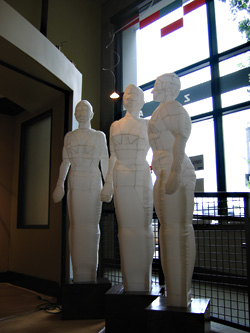Seldom do art dealers pluck from the eager pool of students who graduate each spring with art degrees in hand. It’s simply not a safe bet for business. Whether these artists have gotten a master’s of fine arts (MFA) or a bachelor’s of fine arts (BFA) degree doesn’t much matter. They are still in the midst of developing their own aesthetic sensibilities and will very likely go through numerous changes before settling on a style that is both signature and that works. And yet Viveza, the four-year-old but still relatively unknown gallery in Belltown, has taken this gamble twice.
For the second year in a row, Viveza has put together an exhibition in which the BFA students at Cornish College of the Arts are shown opposite the University of Washington’s MFA students. It’s like a battle of the bands, but for artists.
This curious juxtaposition should be more controversial. Viveza’s not only taking a pretty big risk showing artists who have limited experience, but it’s also very hard to imagine that the MFAs much like being positioned as equals to lowly BFA kids (sorry Cornish). But despite the potentially contentious setup, Viveza hardly gets a second glance from the core of Seattle’s art scene. Artists barely know about the gallery and critics mostly overlook it. The question is, why?
Located near the new sculpture park and in the heart of Belltown’s condo district, Viveza’s a long walk from Pioneer Square’s art hub, and so it could be that it is a little too far off the map to draw the regular crowd. Then again, other galleries like Crawl Space in Capitol Hill and OKOK in Ballard get their fair share of traffic, so it seems unlikely that Viveza’s location is the problem. And while the space it occupies falls outside the norms of the white-cubed gallery—the two-floored retail space was intended to be a three-bedroom apartment, not an art gallery—the art world is used to nontraditional spaces, making it unlikely that Viveza’s odd layout has anything to do with its low profile.
As far as I can tell this leaves only one thing left to blame: Viveza’s very candid mission to attract first-time art buyers, a mission that might be a little too candid for the rest of the art world to swallow. While other galleries hide behind a thin veneer in which money plays second fiddle to art, the Belltown gallery has no shame talking numbers. Whereas the norm is to keep prices confidential—getting a price list on the work in New York’s biggest galleries is like prying information from the Bush administration—and sales are a private matter, at Viveza the walls are dappled with labels that spell out exactly how much something costs and even how much a monthly payment on any given piece would be.
This may sound a little crass to some, putting the buying side of the gallery business a little too much in the limelight. But for those who don’t know anything about buying art, it’s a welcome relief, according to Chad Wasser, manager and publicist for Viveza (pronounced vih-VEH-zah).
“In our experience, the initial art purchase is the most difficult for buyers who see the art world as an insider’s club, fueled by name-dropping snobbery and backroom handshakes,” he says. While this does not paint the most accurate picture of Seattle galleries, which are far more approachable than those in other big cities (like Viveza, most will also work with clients if they need to make monthly payments), at Viveza any guesswork about how you’re going to afford the next bit of art you’re going to purchase is totally eradicated.
When Michael Rivera-Dirks opened the gallery, this was exactly the kind of environment he hoped to create. He wanted people who might be intimidated by the unknowns of art collecting to feel comfortable acquiring original works of art. With high-resolution images of most pieces in inventory available for download online, and hours that jibe with young professionals’ schedules (it’s open until 8 p.m. Thursday and Friday all summer long), Viveza makes the whole process easier.
Viveza’s approach to art is amicable, too. The gallery’s trying to grab the attention of people who would have gone to Ikea or Dania and put a heap of mass-produced prints on their credit cards. Which means that Viveza shouldn’t show heady work, or pieces that are only understood when contextualized by art history. It has to show art that speaks to the guy with no art knowledge. It needs a program that is straightforward, good-looking, and only a little edgy. And you know what? That’s exactly what it has. From Eric Olsen’s dot paintings, in which colorful grids are mapped across metal surfaces, to Christopher Santer’s romantic highways that capture the freedom of the open road, Viveza’s program is solid.
And while this solidity likely explains why Seattle art people haven’t been paying attention to Viveza—it’s just not quite edgy enough—there’s absolutely nothing wrong with the art it shows. It works for Viveza, and if the space continues to be successful, it will also work for the rest of the galleries in town. Or, as Wasser puts it, “We believe by demystifying the art process we are helping [all of] Seattle’s art scene by bringing new, comfortable buyers into the market.” Let’s just hope he’s right: Every art scene could use a bigger consumer base, and Seattle’s certainly no exception.








